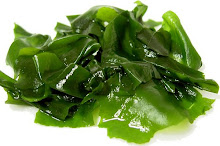

images from algaebase.org
Sea Palm is a brown algae that is very mild tasting with a soft and crunchy texture. As its name suggests, it looks similar to a mini palm tree.
Aliases: Postelsia palmaeformis, palm seaweed
Growing habitat: Sea palm thrives in tubulent waters of the North America, harvested by hand from April thru June. The more turbulent the waters may increase nutrient absorbtion, and reduce competition for rock position. Sea Palm grows on rocks attached by its root-like holdfast. It spends most of its time growing exposed to air due to its long stipe (stem). It can grow to about 2 ft in height and at the top of its stipe grows about 100 leaf-like blades. When in the formation stages, sea palm is green but eventually turns to brown as it matures.
Important Notes: It is illegal to recreationally harvest this sea vegetable. Cutting the stipe prior to spore production can threaten populations. Licensed harvesters use a specific method that reduces impact. Due to their restricted habitat, short life span, and limited power to regenerate, they cannot tolerate heavy harvesting.
History: Before Europeans entered the area, Sea Palm was know by the natives as Kakgunu-chale. It was first scientifically described by Franz Josef Ruprecht in 1852.
Nutrition: Good source of Vitamin A & D, other than that there seems to be little nutritional analysis mentioned anywhere
Uses: Both the blades (leaf-like) and the stipe (less commonly) are edible. Sea palm is delicious raw or sautéed and added to soups or salads.
Preparation: Cover sea palms with water and soak for 20 minutes. Separate the fronds from the stipe and use according to recipe.
Recipes:
Sea Palm Lasagna
Sea Palm with Peanuts
Sea Palm and Cucumber Salad
Sea Palm Salad


No comments:
Post a Comment